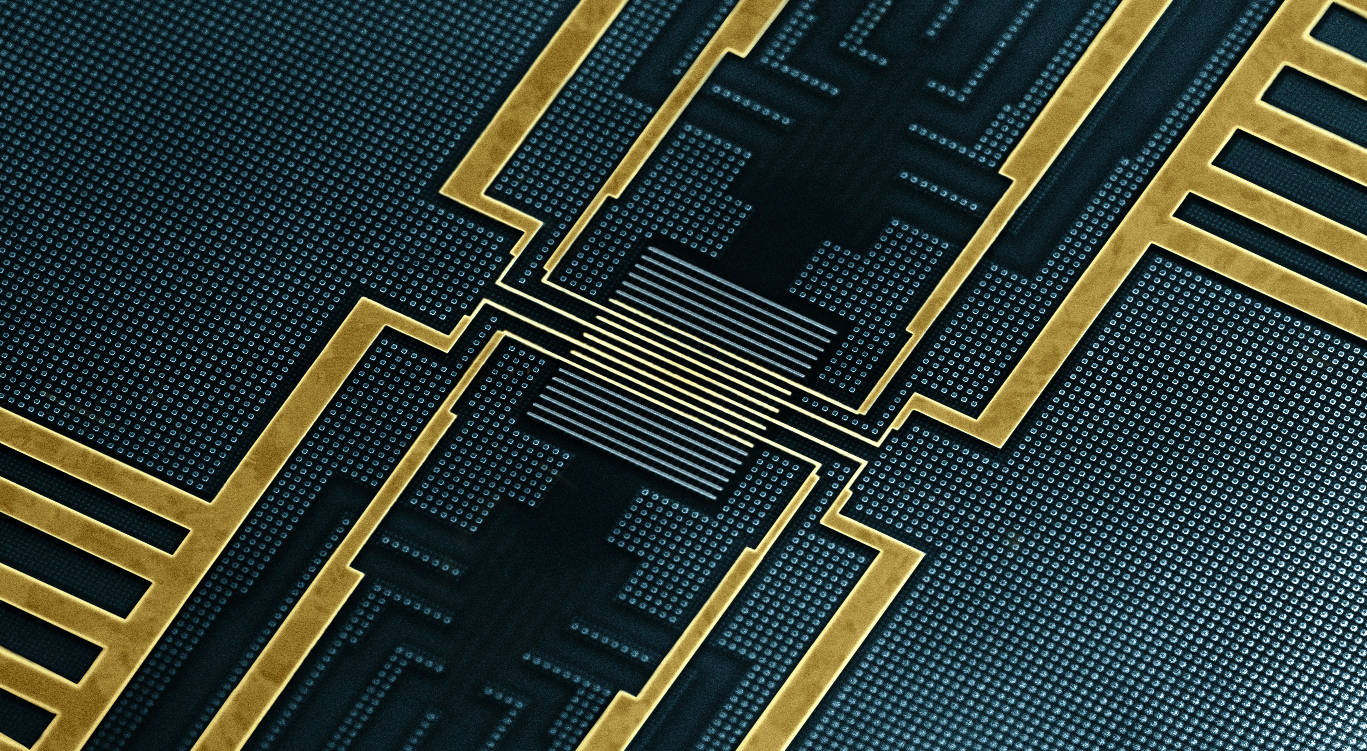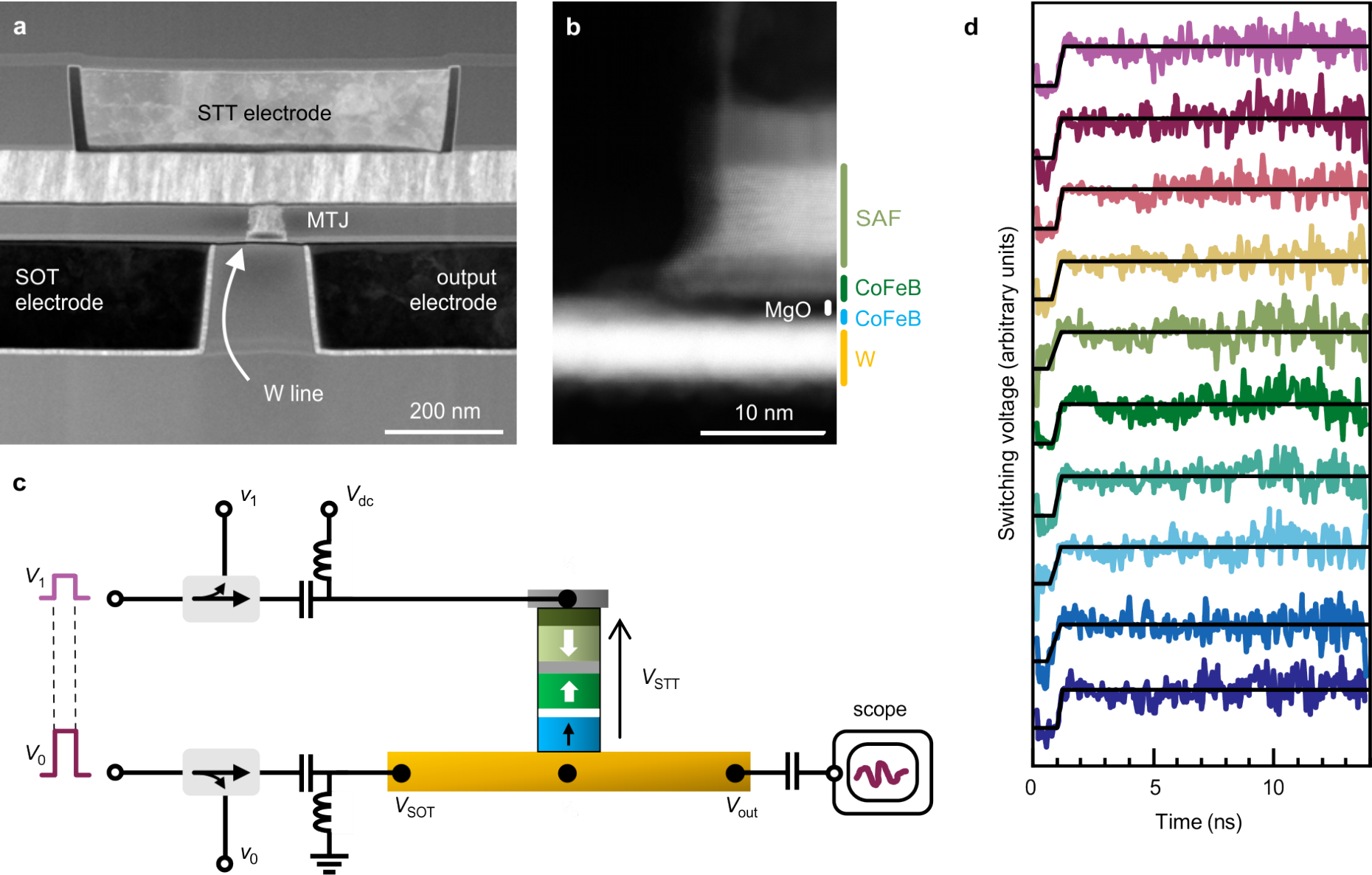Magnetic tunnel junctions and MRAMs

A universal digital memory has to be fast, non-volatile, durable, and low-cost. While all these properties are difficult to combine in a single design, magnetic random access memories, so-called MRAMs, may go a long way in terms of scalability, data retention time, and endurance. MRAMs encode digital bits in the magnetization direction of nm-thick ferromagnetic layers embedded in a magnetic tunnel junction. The state of a bit is read out by a tunneling magnetoresistance measurement and written by current-induced spin transfer torque. In the last years, the optimization of the tunneling magnetoresistance, magnetic anisotropy, and spin transfer torque efficiency in MgO-based tunnel junctions has enabled large read-out signals, long retention times, and electrical switching at moderate current density. Owing to these advances and to their favorable scaling properties, MRAMs are being developed as a non-volatile replacement for SRAMs and eFlash in embedded cache memories, with potential applications also as a persistent DRAM technology.
Our group investigates different methods to switch magnetic tunnel injuctions using spin-orbit torques (SOT) and spin transfer torques (STT). The efficacy of these methods as well as the switching speed depend on the material properties as well as on the design of the magnetic tunnel junction, which is typically composed of the free and reference magnetic layers, the tunnel barrier, and several other layers that are used to pin the magnetization of the reference layer or as buffers to improve the structural quality of the stack. In collaboration with research groups at Spintec, France, and imec, Belgium, we demonstrated the first proof of concept of a CMOS-compatible perpendicular spin-orbit torque magnetic memory cell.
Tracking spin-orbit torque and spin transfer torque switching in magnetic tunnel junctions in real time

The realization of faster memories requires fundamentally novel concepts to overcome the temporal bottlenecks of spin torque magnetization switching, namely the long incubation and broad variability of switching times. Current-induced spin-orbit torques, which arise from the transfer of angular momentum from the lattice to the spin system (as exemplified by the spin Hall and Rashba-Edelstein effects), offer a solution to the switching speed and reliability problem. Differently from spin-transfer torques, which arise from the transfer of spin angular momentum between two magnetic layers having noncollinear magnetization, spin-orbit torques apply also to uniform magnetic textures and do not require the electric current to flow inside a magnet. Further, in a perpendicular magnetic tunnel junction, the spin polarization giving rise to the spin-orbit torques is orthogonal to the quiescent magnetization of the free layer, which reduces the switching incubation time. These properties make spin-orbit torques extremely appealing for ultrafast and reliable MRAMs.

Our single-shot measurements of spin-orbit torque switching of a 3-terminal magnetic tunnel junction disclose the full time-dependent dynamics of magnetization reversal during current injection, unveiling both deterministic and stochastic events. By comparing magnetization switching induced by spin-orbit and spin-transfer torques in the same device, we evidence striking differences in the time scales and efficiency of the two reversal mechanisms. Further, by taking advantage of the multiple bias and magnetic configurations of a 3-terminal magnetic tunnel junction, we demonstrate novel strategies to achieve sub-ns reversal with statistical switching distributions as narrow as 150 ps, that is, at least one order of magnitude narrower compared to state-of-the-art devices. Finally, we analyze the interplay of spin torques, voltage control of magnetic anisotropy, and heat in promoting magnetization reversal, which holds promise for further optimization of the speed and efficiency of 3-terminal devices.
Our study is a collaboration between imec, a leading R&D center in nanoelectronics and digital technologies located in Leuwen, Belgium, and ETH Zurich. All the results have been obtained on industrial-quality magnetic tunnel junction devices fabricated using fully CMOS-compatible processes on a 300 mm pilot MRAM line.
Selected publications
- Tailoring the Switching Efficiency of Magnetic Tunnel Junctions by the Fieldlike Spin-Orbit Torque, V. Krizakova, M. Hoffmann, V. Kateel, S. Rao, S. Couet, G. S. Kar, K. Garello, and P. Gambardella, Phys. Rev. Applied 18, 044070 (2022). Downloadarticle (PDF, 3.8 MB)vertical_align_bottom, Downloadsupplementary information (PDF, 166 KB)vertical_align_bottom
- Spin-orbit torque switching of magnetic tunnel junctions for memory applications, V. Krizakova, M. Perumkunnil, S. Couet, P. Gambardella, and K. Garello, J. Mag. Magn. Mater. 562, 169692 (2022). Downloadarticle (PDF, 5.3 MB)vertical_align_bottom
- Interplay of voltage control of magnetic anisotropy, spin-transfer torque, and heat in the spin-orbit-torque switching of three-terminal magnetic tunnel junctions, V. Krizakova, E. Grimaldi, K. Garello, G. Sala, S. Couet, G. S. Kar, and P. Gambardella, Phys. Rev. Applied 15, 054055 (2021). Downloadarticle (PDF, 1.6 MB)vertical_align_bottom.
- Field-free spin-orbit torque switching in magnetic tunnel junctions at sub-ns timescales, V. Krizakova, E. Grimaldi, G. Sala, F. Yasin, S. Couet, G. S. Kar, K. Garello, and P. Gambardella, Appl. Phys. Lett. 116, 232406 (2020). Downloadarticle (PDF, 6 MB)vertical_align_bottom
- Single-shot dynamics of spin-orbit torque and spin transfer torque switching in 3-terminal magnetic tunnel junctions, E. Grimaldi, V. Krizakova, G. Sala, F. Yasin, S. Couet, G. S. Kar, K. Garello and P Gambardella, Nat. Nanotech. 15, 111 (2020). Downloadarticle (PDF, 5.4 MB)vertical_align_bottom Downloadsupplementary information (PDF, 869 KB)vertical_align_bottom
- Ultra-fast perpendicular Spin Orbit Torque MRAM, M. Cubukcu, O. Boulle, N. Mikuszeit, C. Hamelin, T. Brächer, N. Lamard, M.-C. Cyrille , L. Buda-Prejbeanu, K. Garello, I. M. Miron, O. Klein, G. de Loubens, V. V. Naletov, J. Langer, B. Ocker, P. Gambardella and G. Gaudin, IEEE Trans. Magn. 54, 9300204 (2018). Downloadarticle (PDF, 759 KB)vertical_align_bottom
- SOT-MRAM 300mm Integration for Low Power and Ultrafast Embedded Memories, K. Garello, F. Yasin, S. Couet, L. Souriau, J. Swerts, S. Rao, S. Van Beek, W. Kim, E. Liu, S. Kundu, D. Tsvetanova, K. Croes, N. Jossart, E. Grimaldi, M. Baumgartner, D. Crotti, A. Fumémont, P. Gambardella, G. S. Kar, 2018 IEEE Symposium on VLSI Circuits, pp. 81-82. Downloadarticle (PDF, 1.1 MB)vertical_align_bottom
- Spin-orbit torque magnetization switching of a three terminal perpendicular magnetic tunnel junction, M. Cubukcu, M. Drouard, O. Boulle, K. Garello, C.O. Avci, I. M. Miron, J. Langer, B. Ockert, P. Gambardella, G. Gaudin, Appl. Phys. Lett. 104, 042406 (2014). Downloadarticle (PDF, 980 KB)vertical_align_bottom
- Current-induced spin-orbit torques in ferromagnetic and antiferromagnetic systems, A. Manchon, J. Železný, I.M. Miron, T. Jungwirth, J. Sinova, A. Thiaville, K. Garello, and P. Gambardella, Rev. Mod. Phys. 91, 035004 (2019). Downloadarticle (PDF, 12.4 MB)vertical_align_bottom
